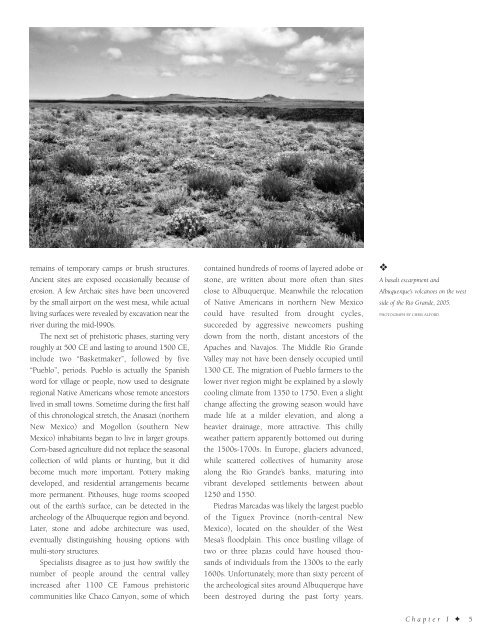Historic Albuquerque
An illustrated history of the City of Albuquerque, New Mexico and the surrounding area, paired with the histories of companies, families and organizations that make the region great.
An illustrated history of the City of Albuquerque, New Mexico and the surrounding area, paired with the histories of companies, families and organizations that make the region great.
You also want an ePaper? Increase the reach of your titles
YUMPU automatically turns print PDFs into web optimized ePapers that Google loves.
emains of temporary camps or brush structures.<br />
Ancient sites are exposed occasionally because of<br />
erosion. A few Archaic sites have been uncovered<br />
by the small airport on the west mesa, while actual<br />
living surfaces were revealed by excavation near the<br />
river during the mid-l990s.<br />
The next set of prehistoric phases, starting very<br />
roughly at 500 CE and lasting to around 1500 CE,<br />
include two “Basketmaker”, followed by five<br />
“Pueblo”, periods. Pueblo is actually the Spanish<br />
word for village or people, now used to designate<br />
regional Native Americans whose remote ancestors<br />
lived in small towns. Sometime during the first half<br />
of this chronological stretch, the Anasazi (northern<br />
New Mexico) and Mogollon (southern New<br />
Mexico) inhabitants began to live in larger groups.<br />
Corn-based agriculture did not replace the seasonal<br />
collection of wild plants or hunting, but it did<br />
become much more important. Pottery making<br />
developed, and residential arrangements became<br />
more permanent. Pithouses, huge rooms scooped<br />
out of the earth’s surface, can be detected in the<br />
archeology of the <strong>Albuquerque</strong> region and beyond.<br />
Later, stone and adobe architecture was used,<br />
eventually distinguishing housing options with<br />
multi-story structures.<br />
Specialists disagree as to just how swiftly the<br />
number of people around the central valley<br />
increased after 1100 CE Famous prehistoric<br />
communities like Chaco Canyon, some of which<br />
contained hundreds of rooms of layered adobe or<br />
stone, are written about more often than sites<br />
close to <strong>Albuquerque</strong>. Meanwhile the relocation<br />
of Native Americans in northern New Mexico<br />
could have resulted from drought cycles,<br />
succeeded by aggressive newcomers pushing<br />
down from the north, distant ancestors of the<br />
Apaches and Navajos. The Middle Rio Grande<br />
Valley may not have been densely occupied until<br />
1300 CE. The migration of Pueblo farmers to the<br />
lower river region might be explained by a slowly<br />
cooling climate from 1350 to 1750. Even a slight<br />
change affecting the growing season would have<br />
made life at a milder elevation, and along a<br />
heavier drainage, more attractive. This chilly<br />
weather pattern apparently bottomed out during<br />
the 1500s-1700s. In Europe, glaciers advanced,<br />
while scattered collectives of humanity arose<br />
along the Rio Grande’s banks, maturing into<br />
vibrant developed settlements between about<br />
1250 and 1550.<br />
Piedras Marcadas was likely the largest pueblo<br />
of the Tiguex Province (north-central New<br />
Mexico), located on the shoulder of the West<br />
Mesa’s floodplain. This once bustling village of<br />
two or three plazas could have housed thousands<br />
of individuals from the 1300s to the early<br />
1600s. Unfortunately, more than sixty percent of<br />
the archeological sites around <strong>Albuquerque</strong> have<br />
been destroyed during the past forty years.<br />
❖<br />
A basalt escarpment and<br />
<strong>Albuquerque</strong>’s volcanoes on the west<br />
side of the Rio Grande, 2005.<br />
PHOTOGRAPH BY CHRIS ALFORD.<br />
Chapter I ✦ 5
















